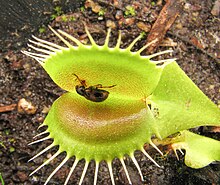Droseraceae
Droseraceae is a small family of carnivorous plants consisting of three genera with 180 species.
Description
They are perennial, insectivorous herbaceous plants that grow in peat bogs or soils poor in nitrogen. Simple leaves, often in a basal rosette, provided with slimy glandular hairs that trap and digest insects, or with leaf segments that capture small prey like traps. Regular, hermaphrodite, dichlamydeous, pentamerous flowers, with 5 free sepals, sometimes slightly united at the base, 5 free petals alternate with the sepals and 5 free stamens alternate with the petals, hypogynous, with syncarpic unilocular gynoecium and 2-5 styles. Capsule fruits.
Genres
About 180 species from warm and temperate regions. Three genera are recognized: Dionaea, Drosera and Aldrovanda.
- Gender
Many fossils are known, but some extinct genera are of doubtful validity.
- Aldrovanda
- Dionaea
- Drosera
- †?Droserapollis
- †?Droserapits
- †?Droseridites
- †?Fischeripollis
- †?Palaeoaldrovanda
- †?Saxonipollis
Taxonomy
The family was described by William Roxburgh and published in The Paradisus Londinensis ad t. 95. 1808. The type genus is: Drosera L.
Contenido relacionado
Catabrous
Cornales
Brassicaceae

